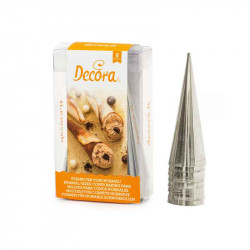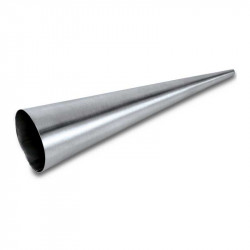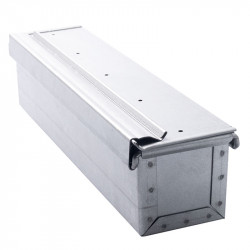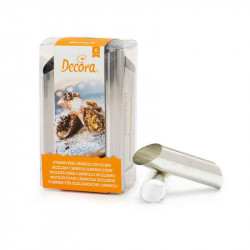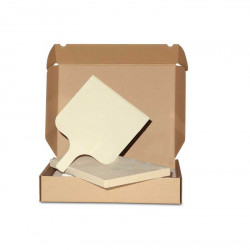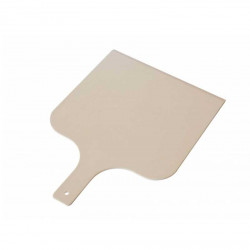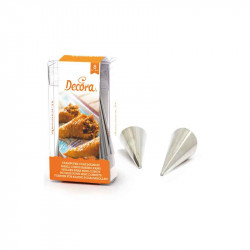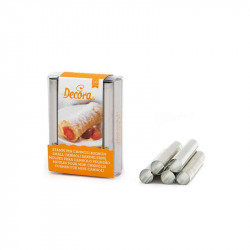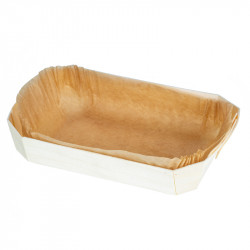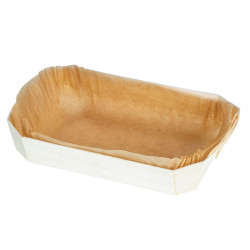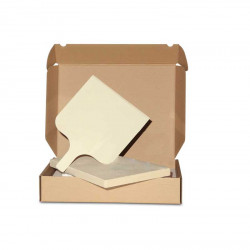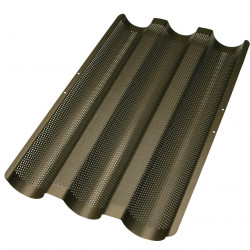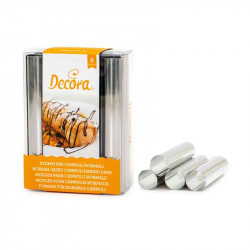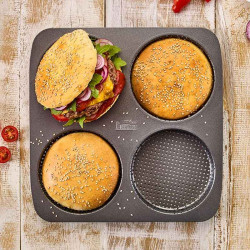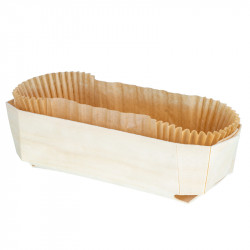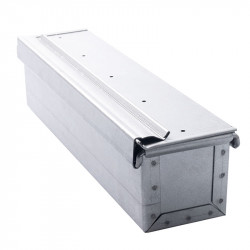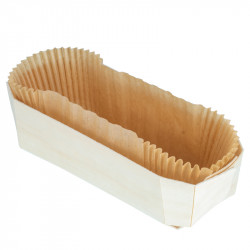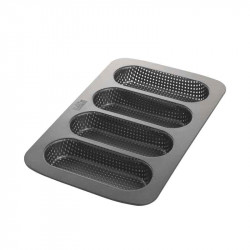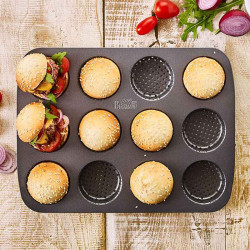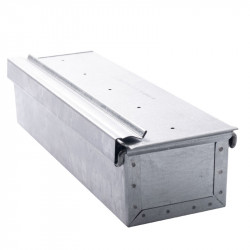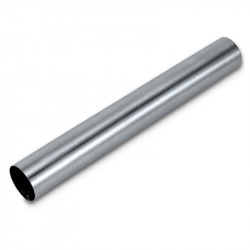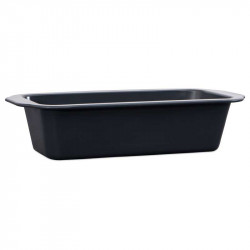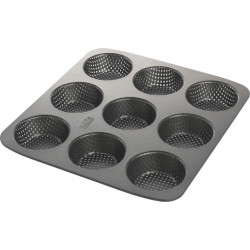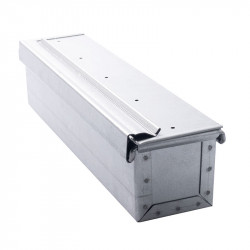Bread baking pans
Why do I need a bread pan?
A bread baking pan is a useful tool for baking bread because it gives the dough a shape and support. Here are some reasons why a bread baking pan can be useful:
1. Uniform shape: A bread baking pan ensures that the dough takes on a uniform shape during the baking process. This is especially important to get an evenly baked bread with an appealing shape.
2. Support: A bread baking pan gives the dough support and prevents it from falling apart or losing its shape during baking. This is especially important if the dough has a high liquid content or has ingredients such as nuts or dried fruit.
3. Crust: Baking in a bread pan ensures that the crust of the bread bakes evenly and takes on an attractive golden color. Without a pan, the crust may be flat and less crisp.
4. Easy removal: after baking, the bread can be easily removed from the bread pan without sticking or falling apart. This makes it easier to serve and store the bread.
It is important to note that a bread baking pan is not necessary for all bread recipes. There are many bread varieties, such as baguettes or ciabatta, that are baked without a bread pan. It depends on the desired result and the recipe whether a bread baking pan is recommended.
What bread pans are the best for baking?
The best bread pans for baking depend on personal preferences and needs. However, here are some popular options:
1. Proofing baskets (banneton): These round or oval baskets made of wicker or wood are ideal for fermenting sourdough breads. They give the bread a nice shape and structure the dough during fermentation.
2. Loaf pans: These rectangular baking pans are ideal for baking loaves of bread. They create an even shape and allow the bread to be easily sliced.
3. Baguette Molds: These long, narrow baking pans are ideal for making baguettes or other long breadsticks. They help shape the dough into the typical elongated shape.
4. Roman Pot: These traditional clay pans are perfect for baking sourdough bread or rustic loaves. The clay absorbs moisture and provides a crispy crust.
5. Silicone or glass molds: These flexible molds are easy to clean and come in a variety of shapes and sizes. They can be used for different types of bread and often have a non-stick coating.
It is important to choose a bread pan that suits your needs and works well with the type of bread or dough you are baking. Ultimately, personal preference and experience plays a big role in choosing the best bread pan.
What to consider when buying bread molds?
When buying bread molds, the following should be considered:
1. Material: Bread molds are usually available in metal or silicone. Metal molds distribute heat evenly and produce a crispy crust, while silicone molds are flexible and easy to clean.
2. Size: The size of the bread pan should be matched to the desired bread size. There are different sizes and shapes, e.g. oblong molds for baguettes or round molds for loaves.
3. Non-stick coating: A non-stick coating makes it easier to remove the bread from the mold and facilitates cleaning.
4.Heat Resistance: Make sure the bread pan is heat resistant and can withstand the required temperatures.
5. Handling: Make sure the bread pan is easy to handle and has handles or side rims for easy removal of the bread.
6. Cleaning: Check to see if the bread pan is dishwasher safe or allows for easy cleaning.
7. Manufacturer reviews: Read reviews from other buyers to get an idea of the bread pan's quality and reliability.
8. Price: Compare the prices of different bread pans to get good value for your money.
What material should a bread pan be made of?
A bread pan can be made of various materials, including:
1. Metal (e.g. stainless steel, aluminum): Metal baking pans are sturdy and durable. They distribute heat evenly and ensure even browning of the bread. They are also easy to clean.
2. Silicone: Silicone baking pans are flexible and easy to handle. They are non-stick and easy to remove from the bread. They are also dishwasher safe.
3. Glass: Glass baking pans are heat resistant and allow for a good view of the baking process. They retain heat well and produce even browning. However, they can be harder to clean than other materials.
The choice of material depends on personal preference and requirements. It is important that the baking pan is heat resistant and has a good non-stick coating so that the bread can be easily removed from the pan.
How to properly clean a bread pan?
To clean a bread pan, you can follow these steps:
1. Allow the pan to cool before cleaning.
2. Remove excess bread crumbs from the pan by gently shaking it out or wiping it with a kitchen towel.
3. Fill the pan with warm water and add some dishwashing liquid. Let the pan soak for a few minutes to loosen any dried dough residue.
4. Use a soft brush or sponge cloth to thoroughly clean the entire surface of the baking pan. Take special care to reach all corners and edges.
5. Rinse the baking pan thoroughly with warm water to remove all soap residue.
6. Dry the baking pan thoroughly before storing it to prevent rusting.
For stubborn stains, you can also use a mixture of baking soda and water to clean the baking pan. Apply the paste to the stained areas and let it sit for a few minutes before rinsing with warm water and drying.
What to look for when buying a bread pan?
When buying a bread pan, you should pay attention to the following points:
1. Material: Bread pans are available in different materials such as metal, ceramic or silicone. Metal is generally the most suitable, as it allows for even heat distribution.
2. Size: Consider what size the bread pan should be. Depending on how big you want your bread to be, you will need different sizes.
3. Non-stick coating: Make sure that the bread pan has a good non-stick coating so that the bread can slide out of the pan more easily when you remove it.
4. Stability: The bread pan should be stable and well-made so that it does not slip away or bend during baking.
5. Heat resistance: Check whether the bread pan is suitable for high temperatures. Most molds are suitable for temperatures up to about 250°C.
6. Cleaning: Consider how easy it is to clean the bread pan. A dishwasher-safe pan may make cleaning easier.
7. Extras: Some bread pans have extras such as lids or inserts for baguettes. Decide if you need such extras.
8. Customer reviews: Read customer reviews and testimonials to get an idea of the quality of the bread pan.
By considering these points, you can find the right bread pan for your needs.
Should you actually grease a bread pan?
It depends on what material the bread pan is made of.
- Silicone baking pans usually do not require greasing as they have a non-stick surface.
- Metal baking pans, such as aluminum or copper, are recommended to be lightly greased before baking to prevent the bread from sticking.
It is advisable to follow the manufacturer's instructions as some pans may have specific instructions for care and use.
What kind of material is a bread pan made of?
A bread pan can be made of different materials. The most common materials are metal (such as aluminum or stainless steel), glass or ceramic. Each material has its advantages and disadvantages. Metal baking pans are usually durable, conduct heat well, and allow for even browning of the bread. Glass baking pans are transparent, so you can watch the baking progress, and are usually heat resistant as well. Ceramic baking pans often provide a nice, rustic look and can retain heat well. Ultimately, the choice of material depends on the baker's individual preferences and needs.
What all distinguishes the bread molds from brand manufacturers?
Brand-name bread molds have several features that can distinguish them from conventional bread molds:
1. Material quality: Brand-name manufacturers usually use high-quality materials such as stainless steel, silicone or ceramic. These materials are often durable and can provide better heat distribution.
2. Non-stick coating: many brand-name manufacturers use a non-stick coating in their bread baking pans to prevent the dough from sticking. This makes the bread easier to remove from the pan and simplifies cleaning.
3. Size Selection: Brand name manufacturers often offer a wide range of different sizes and shapes of bread baking pans. This makes it possible for everyone to find the right mold for their individual needs.
4. Functionality: Brand manufacturers often place great emphasis on the functionality of their bread baking molds. You can have special features such as locking mechanisms, handles, or even inserts for different types of bread.
5. Design: Bread molds from brand-name manufacturers often have an aesthetically pleasing design. They may have different colors and shapes that make bread baking a pleasurable experience.
6. Additional Warranty: Some brand-name manufacturers may offer a longer warranty on their bread molds to emphasize quality and durability.
It is important to note that not all bread molds from brand-name manufacturers have all of these features. It pays to read product descriptions and customer reviews carefully to select the right bread pan to meet individual requirements.
Which bread baking pan also serves as a proofing basket?
A bread baking pan that can additionally be used as a proofing basket is a so-called proofing basket mold or bread proofing basket. These molds have a round or oval shape and are usually made of rattan or woven cane. They are used during the fermentation phase of the dough to give the bread its shape and help it rise. After rising, the dough can be removed from the mold and placed directly in the oven to be baked. These baskets are very popular in the production of bread, as they give the bread a beautiful shape and texture.
What are the different bread molds for bread baking?
There are a variety of different bread pans or loaf pans that can be used for baking bread. Here are some examples:
1. loaf pan: A rectangular pan with straight sides and a flat bottom. This is a commonly used pan for bread types such as toast or sandwich bread.
2. Round Basket: A round, braided or patterned shape often used for proofing dough. The shaped dough is placed in the basket and then allowed to proof in it before baking. This can create a beautiful shape and texture on the bread.
3. Baguette Shape: A long, narrow shape with straight sides designed specifically for baking baguettes. This mold allows you to achieve the characteristic elongated shape and crispy crust of baguettes.
4. Gugelhupff mold: A round mold with a tall, cone-shaped center section and a hole in the middle. Although primarily used for baking cakes, it can also be used for certain bread variations such as the Gugelhupf.
5. Bread stone: Although not a traditional mold in the strictest sense, a bread stone is often used to bake bread in a special way. The stone absorbs moisture and retains heat evenly, which can result in a crispier crust and textured texture.
These are just a few of the many different bread shapes available. Depending on the desired style of bread or personal preferences, you can choose the appropriate shape.
Where to buy a bread pan?
A bread baking pan can be purchased in various stores and online stores. Possible places include:
1. Specialty stores for baking accessories: In specialty stores or household stores that specialize in kitchen utensils and baking accessories, you can also find bread baking molds in various designs.
2. Online stores: There are numerous online stores that offer a wide selection of bread baking pans.
3. kitchen departments in department store chains.
It is advisable to check the availability of the desired bread baking pan in the respective stores in advance or to seek advice on site. Online stores often offer the possibility to read customer reviews to better assess the quality and functionality of the products.
What is the difference between a proofing basket and a bread pan?
A proofing basket, also called a baker's basket or proofing basket, is used to shape the dough into a certain form while it is left to rise and proof. It is usually made of natural material such as wicker or wood and has a round or oval shape. The proofing basket allows air to circulate evenly around the dough, creating a beautiful pattern on the surface of the bread.
A bread pan, on the other hand, is a mold used to bake bread in the oven. It can be made of different materials such as metal or ceramic and is usually rectangular in shape. The bread baking pan holds the dough in the desired shape during the baking process and ensures an even distribution of heat.
So the main difference is that the proofing basket shapes the dough during the proofing process, while the bread baking pan shapes the dough during the baking process.

